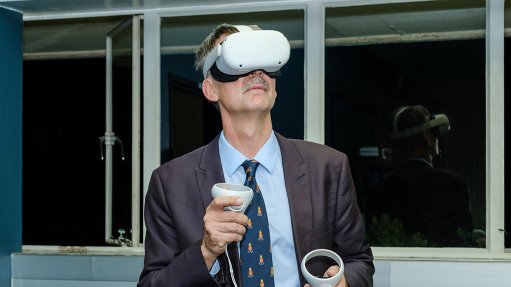Institute engages DTI to increase local content requirements


AFRICAN HICCUP Despite the growth in structural steel use in other parts of Africa, local export tonnages have not increased
Industry body for the promotion of the steel construction industry the Southern African Institute of Steel Construction (Saisc) is in discussions with the Department of Trade and Industry (DTI) to increase local product content requirements for future industrial projects, Saisc CEO Paolo Trinchero tells Engineering News.
“A substantial amount of steel is used in the construction of renewable-energy projects and a substantial amount of steel was imported for use in projects in the first two rounds of the Renewable Energy Independent Power Producer Procurement Programme (REIPPPP),” he states.
Trinchero emphasises that there was no need to import most of the steel, as it is available locally.
However, he says Saisc is encouraged by the DTI’s gradual increase in local content requirements for REIPPPP projects in every round and he believes even more can be done.
“We are in discussions with the DTI about designating structural steel for all future new build power station programmes, whether they be nuclear or coal,” he states.
Moreover, Saisc industry development executive Kobus de Beer explains that, although the development of new power stations has not been formalised by government – as the construction of State-owned power utility Eskom’s Medupi and Kusile coal-fired power stations, in Limpopo and Mpumalanga respectively, is still ongoing – it is important that when the development of Coal 3 or a new nuclear power station gets under way, the bulk of the steel and steel fabrication works be sourced locally.
“We would like to see the localisation and designation of fabricated steelworks, as well as the correct implementation of import duties on all imported fabricated steelworks. This will ensure that the local industry receives the maximum benefit from all future power station development projects,” states De Beer.
Moreover, he stresses, Saisc is concerned not only about saving the fabrication industry. “We would also like to see an increase in the local engineering stake in all industrial projects.”
De Beer believes that it has been “unavoidable” that foreign firms won contracts for the bulk of the primary engineering work for the Medupi and Kusile projects, while local engineering companies were able to tender only for subcontractor work.
“We need to develop local engineering capacity – greater efforts are required by government and industry players to ensure skills development takes place through all future new build projects,” he emphasises.
De Beer, who worked on the construction of the Duvha and Majuba coal-fired power stations, in Mpumalanga, says: “The . . . [bulk] of the work on these power stations was undertaken locally.”
He adds that a significant portion of the final engineering work on Medupi and Kusile was carried out by local engineering companies, which clearly shows that many of the skills required to build and operate Eskom’s new power stations are available locally.
Export Analysis
Trinchero says South Africa exported about 150 000 t of HS7308 structural steel in 2013, which is the average amount that the country has been exporting over the past five years.
“We are deeply concerned that, despite the growth in structural steel use in other parts of Africa, local export tonnages have not increased.”
Trinchero points out that Saisc’s sister organisation, the International Structural Steel Fabricators of South Africa, is seeking out projects in Africa and facilitating South African involvement in new projects.
However, he says a barrier to increasing export tonnages into the rest of Africa is import duties.
“Additionally, we have to compete with certain Asian steel suppliers that are receiving State subsidies in the manufacturing and exporting of goods, while South African companies do not receive such subsidies, which impacts on companies’ ability to compete cost effectively.”
Nonetheless, De Beer stresses that South African steel manufacturing companies are largely still able to compete with their Asian counterparts in terms of price and quality, particularly on smaller projects, such as the building of shopping centres and airports.
Comments
Announcements
What's On
Subscribe to improve your user experience...
Option 1 (equivalent of R125 a month):
Receive a weekly copy of Creamer Media's Engineering News & Mining Weekly magazine
(print copy for those in South Africa and e-magazine for those outside of South Africa)
Receive daily email newsletters
Access to full search results
Access archive of magazine back copies
Access to Projects in Progress
Access to ONE Research Report of your choice in PDF format
Option 2 (equivalent of R375 a month):
All benefits from Option 1
PLUS
Access to Creamer Media's Research Channel Africa for ALL Research Reports, in PDF format, on various industrial and mining sectors
including Electricity; Water; Energy Transition; Hydrogen; Roads, Rail and Ports; Coal; Gold; Platinum; Battery Metals; etc.
Already a subscriber?
Forgotten your password?
Receive weekly copy of Creamer Media's Engineering News & Mining Weekly magazine (print copy for those in South Africa and e-magazine for those outside of South Africa)
➕
Recieve daily email newsletters
➕
Access to full search results
➕
Access archive of magazine back copies
➕
Access to Projects in Progress
➕
Access to ONE Research Report of your choice in PDF format
RESEARCH CHANNEL AFRICA
R4500 (equivalent of R375 a month)
SUBSCRIBEAll benefits from Option 1
➕
Access to Creamer Media's Research Channel Africa for ALL Research Reports on various industrial and mining sectors, in PDF format, including on:
Electricity
➕
Water
➕
Energy Transition
➕
Hydrogen
➕
Roads, Rail and Ports
➕
Coal
➕
Gold
➕
Platinum
➕
Battery Metals
➕
etc.
Receive all benefits from Option 1 or Option 2 delivered to numerous people at your company
➕
Multiple User names and Passwords for simultaneous log-ins
➕
Intranet integration access to all in your organisation


















